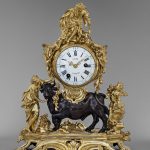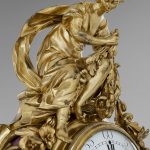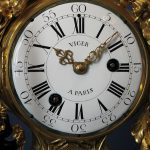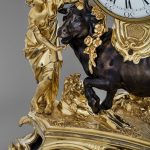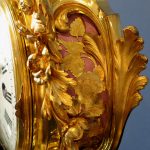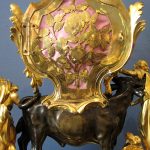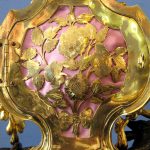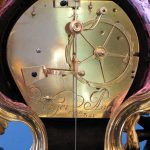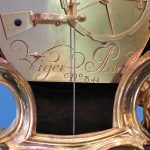Charles-Alexandre de Lorraine’s Rape of Europa mantel clock
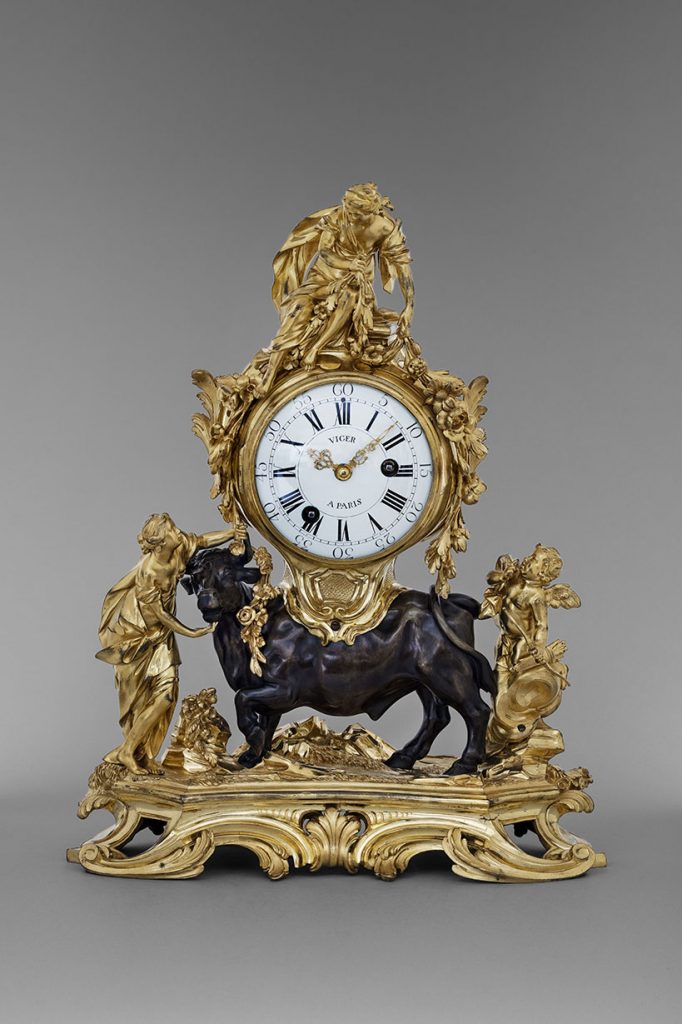
A Louis XV gilt and patinated bronze mantle clock
representing the Rape of Europa,
the dial signed Viger à Paris, the movement signed Viger à Paris N° 841 – circa 1755
François Viger (1708-1784)
The case attributed to Jean-Joseph de Saint-Germain
(1719-1791, maître in 1748)
Height: 57 cm. (22 ½ in.) Width: 45.5 cm. (18 in.) Depth: 19.5 cm. (7 ¾ in.)
The case represents Zeus disguised as a bull being draped with flowers by Europa who is seated on the clock case, an attendant and Cupid kneeling on a cloud.
Provenance
Collection of Prince Charles-Alexandre de Lorraine; his sale, Brussels, 21 May 1781, lot 6 (Pendules), sold for 240(?): “Une grande pendule, faite par Viger, à Paris ; la boîte de bronze, avec trois figures de même, représentant l’enlèvement d’Europe : le tout, bien doré ; le mouvement de quinze jours, sonnant les heures & la demie”.
Collection of Mr Demachy; his sale, Galerie Georges Petit, Paris, 24 May 1912, lot 41 (ill.)
Collection of Hector Beeche; his sale, Hôtel Drouot, Paris, 11-12 June 1947, lot 74 (ill.)
Comparative Literature
J.Harris, Buckingham Palace and its Treasures, New York, 1968, pp. 200-201.
H.Ottomeyer & P. Pröschel, Vergoldete Bronzen, Munich, 1986, p. 125, no. 2.8.9.
T.Wolvesperges, ‘Les achats parisiens de Charles-Alexandre de Lorraine’, in S. Raux (ed.), Collectionner dans les Flandres et la France du Nord au XVIIIe siècle : actes du colloque international, Lille, Université Charles-de-Gaulle-Lille 3, 13-14 mars 2003, Villeneuve-d’Ascq, 2005, pp. 183-201.
L. de Ren, ‘Le Protecteur des Arts’, in L. de Ren (ed.) Charles-Alexandre de Lorraine, prince de l’Europe des Lumières, Ars sur Moselle, 2012, pp. 52-61
Charles-Alexandre de Lorraine
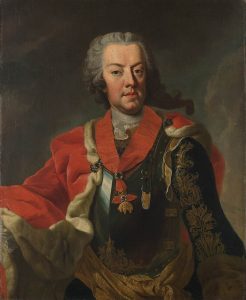 Martin van Meytens, Prince Charles-Alexandre de Lorraine, 1743
Martin van Meytens, Prince Charles-Alexandre de Lorraine, 1743
©Kunsthistorisches Museum Vienna (Gemäldegalerie, 2731
Charles-Alexandre de Lorraine (1712-1780), brother-in-law of Empress Maria Theresa of Austria and governor-general of the Austrian Netherlands, was a famous amateur and renowned collector, whose taste straddled the luxury of the courts of Vienna and Paris.
What makes the prince such an interesting collector and patron of the arts is that his collecting evolved through many decades, and so encompassed both the latest neo-classical taste (he repeatedly ordered in pieces by Roentgen for example), whilst retaining a fondness for objects in the rococo style such as this clock.
The sale of the prince’s collections, organized the year after his death in May 1781, bore witness to his exceptional taste, which had been satisfied at the expense of considerable debts run up with the Imperial court. Many pieces were bought back by the emperor Joseph II, who sent agents to Brussels to repossess them in part-satisfaction of these debts and they remain in Vienna to this day.
The Rape of Europa model
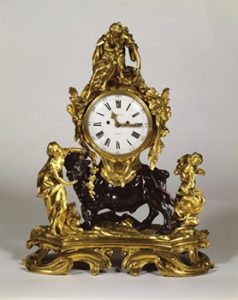 Royal Collection Trust / © Her Majesty Queen Elizabeth II 2018 (RCIN 2822)
Royal Collection Trust / © Her Majesty Queen Elizabeth II 2018 (RCIN 2822)
This particular model of Europa and the Bull was commercialised by the bronzier Jean-Joseph de Saint-Germain.
- An identical clock signed by him was sold Sotheby’s London, 25 June 1965, lot 77.
- Another example signed Jolly à Paris is part of the collection of the Fitzwilliam Museum, Cambridge and is reproduced in Ottomeyer & Pröschel, cit., p. 125, no. 2.8.9.
- A further one is in the collection of H.M. the Queen, illustrated in Harris, cit., pp. 200-201.
This example is the only one signed by Viger and the exceptional quality of the casting and finish further confirms the prestigious provenance in the collections of Charles-Alexandre de Lorraine.

